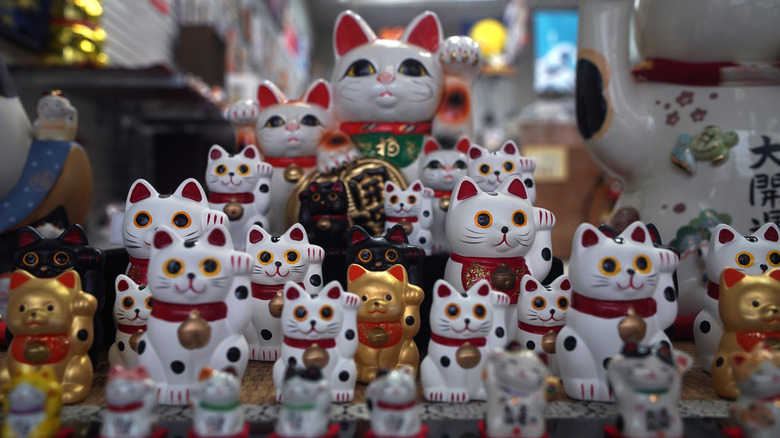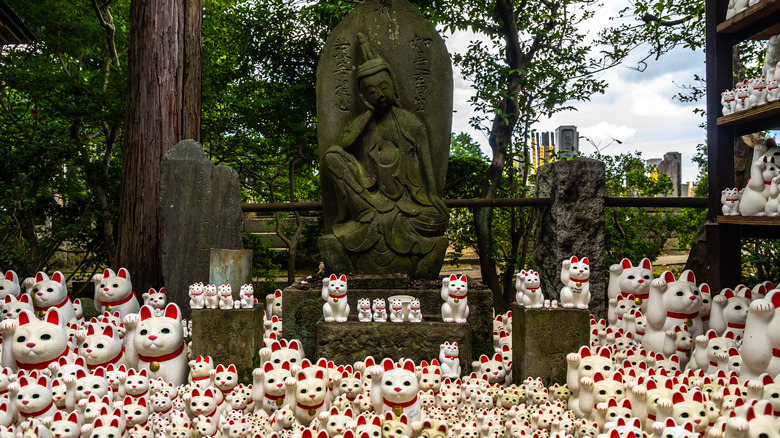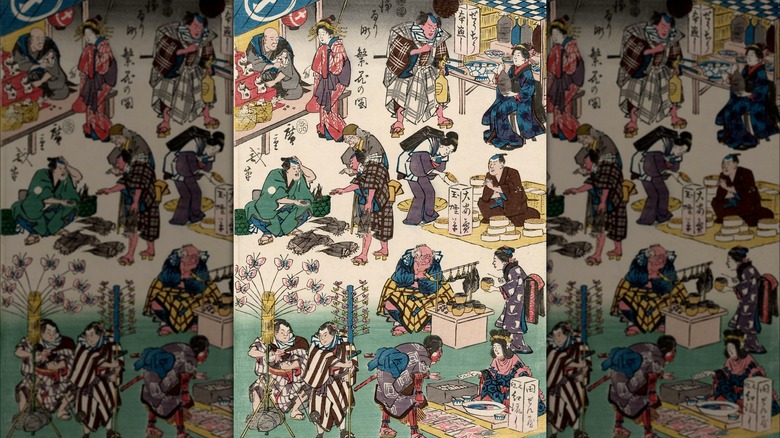The Legend Of The Iconic Waving Lucky Cat Explained
Found throughout Asia as well as in Asian restaurants around the globe, the lucky cat can be seen greeting visitors everywhere from tearoom tabletops to Tokyo taverns. Referred to as the "Maneki-Neko" (the beckoning cat) in Japanese, the electronic version of this novelty ornament can be seen waving hypnotically all over the world today — but don't be fooled by its modern appearance — the symbol of the lucky cat has been around for a long time.
The welcoming feline is a bringer of good fortune and material wealth and it is associated with many myths and legends in Japan. Modern versions of the Maneki-Neko appear in many different guises depending on what the hopeful owner is wishing for. Some people maintain that the pink version of the statue is designed to attract luck in love for example, while the white cat is connected to purity and happiness, and the gold cat can provide general prosperity. Live Japan maintains that a raised left paw attracts customers, while a raised right paw brings wealth. When both paws are raised, the cat brings protection.
Both Tokyo and Osaka have claimed ownership of the popular feline and very little has been definitively confirmed about the cat's mysterious origins. Whatever the case may be, the popularity of the adorable (and allegedly magical) kitten, shows no signs of slowing down.
Legends about the waving cat
Although his origins are disputed, it is widely believed that the inviting feline came from one specific temple in Tokyo, according to CNN. Today, the Gotokuji Temple is awash with statues of lucky cats and there are many stories explaining why.
According to one version of events, in the 1400s, an impoverished temple monk was given a great gift due to his beloved cat. The feline raised its paw to catch the attention of some wandering samurai, who were caught in a rainstorm. After finding shelter and sharing food with the monk, one of the men (a wealthy lord) was inspired by the man's Buddhist creed. He decided to donate land to the temple as a thank-you, making the institution prosperous at last. Another version of this myth runs that during the Edo Period (1603-1868), a local lord was saved from a lighting bolt while out hunting when an abbot's cat waved him into the temple for shelter.
On the other hand, those who favor the Imado Shrine near Asakusa, Tokyo, as the cat's place of origin, believe that in the 19th century, a poor elderly lady was forced to give up her pet when she could no longer afford to look after it. The cat returned to her in her dreams, instructing her to make models of the animal for good luck. She sold the cat dolls she created at a local shrine, and her get-rich-quick scheme did indeed reverse her fortunes.
Money-bringer or money-maker?
Legends aside, the real origins of the lucky cat may actually be slightly sordid. Researchers from the University of California Irvine found that Meneki-Neko talismans suddenly became very popular in the Meiji Period (1868-1912) and it is believed that they were used to replace the phallic good luck symbols that were traditionally displayed in brothels after they were banned. One of the oldest known depictions of the animal according to the MET Museum, is a woodblock print dating to just 1852.
Whatever the truth behind the statue's abundant folklore, the sale of Maneki-Neko statues has become something of a cottage industry in Japan. Whether or not you believe they bring money to those who own them, they certainly bring money to those who sell them. The Gotokuji temple alone sells a huge number of the popular charms every day to enamored tourists and in modern times the lucky cat is also believed to have inspired the Pokemon Meowth, among other pop culture icons.
Today, the ornaments come in all manner of guises from piggy banks to key chains, and they are often depicted together with other traditional symbols of wealth and luck, such as coins, koi carp, fans, and drums. The lucky cat is also fortunate enough to have its own festival — Maneki-neko Day — celebrated in many cities in Japan each year.


